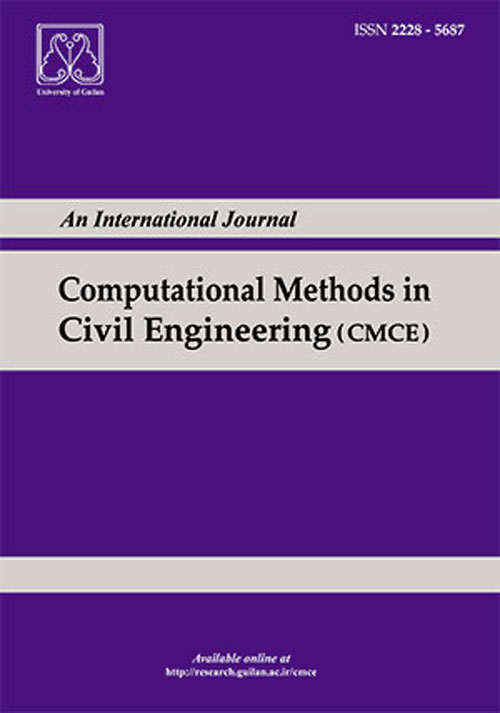فهرست مطالب
Computational Methods in Civil Engineering
Volume:3 Issue: 1, 2012
- تاریخ انتشار: 1391/10/25
- تعداد عناوین: 6
-
Page 1This paper uses a PSOPC model based non-destructive damage identification procedure using frequency and modal data. The objective function formulation for the minimization problem is based on the frequency changes. The method is demonstrated by using a cantilever beam, four-bay plane truss and two-bay two-story plane frame with different scenarios. In this study, the modal data are provided numerically using the finite element method. The effectiveness of using frequencies as the data for quantification of damage severity and location are checked. The effects of noisy incomplete data on the accuracy of damage detection with PSOPC algorithm are also discussed.Keywords: Damage identification, Finite element method, Modal data, PSOPC algorithm
-
Page 15Geometric and material nonlinear behavior of slender webs in I-column girders having stocky flanges under the action of combined lateral and axial loads is investigated. Interaction curves corresponding to the application of compressive and shear loads at buckling and ultimate stages for both web plates and column sections are plotted. In addition, the effects of flange and web slenderness ratios on the behavior of columns are studied. Results show that the effect of compressive loads on decreasing shear buckling and ultimate capacities of slender web plates is more than the effect of shear on the relative axial capacities. In the case of dominant compressive loading, the increase of shear force does not reduce the ultimate axial capacity of web plates.Keywords: Web plate, Interaction, Compression, Shear
-
Page 35An enhanced displacement feedback structural control procedure is presented for performance-based design in this paper. At first, a comparative study is implemented assessing three most common active control algorithms including state, acceleration, and displacement feedback controls. The advantage of the displacement feedback algorithm for active control of structures against earthquakes is demonstrated through a number of representative examples. Second, the conventional displacement feedback control is modified to keep the lateral displacements under a preset value and to apply the control forces only when needed not continuously, hence to minimize the input energy. The lateral displacement at a certain level, e.g., the roof, is used as an on/off switch for the applied control forces. When the target displacement is going to be exceeded, the control forces are applied to reduce the displacements. As a result, it is shown that use of the proposed algorithm considerably reduces the energy demand of the control system compared to other procedures. Moreover, response of structure is controlled to any desired limit.Keywords: Active control, State, Acceleration, Displacement, Feedback, Target
-
Page 51Yielding elements (YE) are among those devices that not only help control structural damages, but make better seismic behavior by concentrating the frames in some removable part of the structures. YE are located at the intersection of Concentric Braced Frame (CBF) in a rectangular shape. In this paper, Seismic behavior of the frames with YE will be investigated. For this reason, 5 braced steel frames with different stories (3, 5, 7, 10 and 15) equipped with yielding elements and diverse opening percentages (10, 20, 30, 40 and 50) are modeled in the Opensees software. At first, through a linear static analysis, the stiffness of these frames is investigated, taking into account changes in the size of the YE and the increasing height of the frames. Subsequently, through some nonlinear dynamic analysis, an attempt is made to investigate their seismic behaviors including stiffness and resistance in different records of earthquake. Finally, the R factor of those optimized frames is calculated. The results show the efficiency of these elements in making a better seismic behavior.Keywords: Seismic behavior, Yielding damper, Steel brace, R factor, Nonlinear dynamic analysis
-
Page 63A constitutive model based on two–dimensional unstructured Galerkin finite volume method (GFVM) is introduced and applied for analyzing nonlinear behavior of cracked concrete structures in equilibrium condition. The developed iterative solver treats concrete as an orthotropic nonlinear material and considers the softening and hardening behavior of concrete under compression and tension by using two equivalent uniaxial stress–strain relations. The concepts of current strength in a principal stress space and secant stiffness matrix are utilized to describe the biaxial behavior of concrete and the post–peak progress of stress–strain relation is modeled using the fracture energy method. Moreover, a smeared rotating crack method (SRCM) formulation is implemented in the solver to spot the nonlinear behavior of damaged structure. In order to demonstrate the performance of the model at a structural level, available experimental results of a notched beam under three point bending are presented. With the intention of demonstrating the post–peak performance of the model, the procedure of loading is simulated by imposing an incremental monotonic displacement. The envelope curve of equivalent load versus crack mouth opening displacement (CMOD) is utilized to evaluate the accuracy of the introduced method.Keywords: Iterative Galerkin finite volume method, Smeared rotating crack method, Cracked concrete softening, hardening, Equilibrium condition
-
Page 77Seismic waves are filtered as they pass through soil layers, from bedrock to surface. Frequencies and amplitudes of the response wave are affected due to this filtration effect and this will result in different ground motion characteristics. Therefore, it is important to consider the impact of the soil properties on the evaluation of earthquake ground motions for the design of structures. Soil properties in a heterogeneous soil layer are affected by a series of uncertainties. Inherent variability of shear modulus contributing most to the overall uncertainty is described and modeled in this paper using deterministic and stochastic field representations. This paper highlights the importance of the effect of the stochastic components of the heterogeneity of shear modulus on response behavior of natural alluvial deposits in comparison to the deterministic consideration. The results emphasize that stochastic heterogeneity has significant effects in dynamic properties of natural alluvial deposits and its negligence would result in an over estimation of the fundamental frequency of spatially variable alluvial deposits.Keywords: Natural frequency, Inherent variability, Shear modulus, Stochastic fields, Natural alluvial deposits


